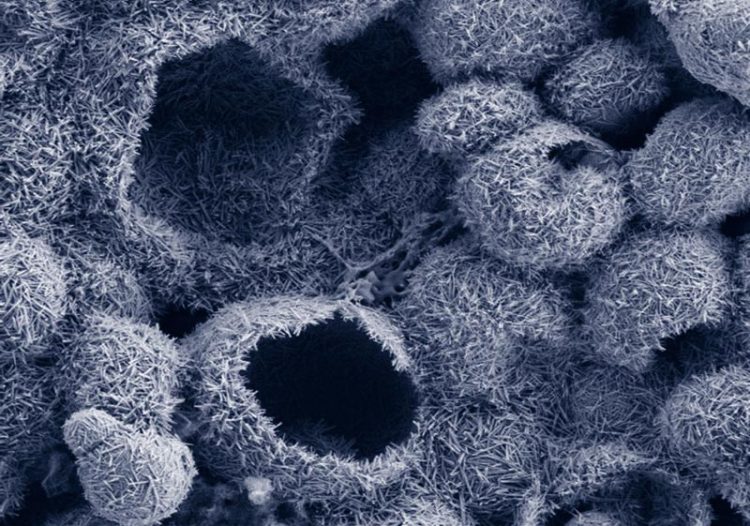A coating that protects against heat and oxidation

Hollow balls of aluminum oxide are fi lled with gas. Scientists have developed an economical way of manufacturing these insulators. © Fraunhofer ICT
Gases don’t conduct heat as well as solids do. Cellular or aerated concretes take advantage of this effect, which experts call “gas-phase insulation”.
The heat barrier is achieved by air encased in the cavities of the concrete. But gas-phase insulation has far greater potential than keeping our homes warm. It can also be used to protect turbine engine and waste incinerator components when subjected to intense heat. All you need to do is transfer this effect to a coating that is just a few hundred micrometers thick.
Temperature differences of over 400 degrees Celsius
Scientists at the Fraunhofer Institute for Chemical Technology ICT in Pfinztal have not only done just that, they’ve also done it in a particularly economical way. They’ve designed a coating that consists of an outer topcoat from conjoined aluminium oxide spheres.
“These spheres are hollow and filled with gas,” explains coatings expert Dr. Vladislav Kolarik from the ICT’s Energetic Systems department. When the outer side of a part is exposed to temperatures of 1000 degrees Celsius, these gas-filled spheres reduce temperatures on the part’s inner side to under 600 degrees Celsius – as the ICT scientists have demonstrated in their laboratories.
Since gas and steam turbines used for energy generation, combustion chambers, waste incinerator generators and temperature sensors, and reactors in the chemical and petrochemical industries are all subjected to temperatures of up to 1000 degrees Celsius, there is considerable demand of thermal protection.
What’s most remarkable is that the heat insulating layer from hollow aluminium oxide spheres is obtained on the basis of a conventional, economic process. Operators only have to do some simple math to see the benefits: conventional thermal barrier techniques – most of which are based on ceramic materials – are expensive. The process the scientists adapted was originally designed to protect metallic components from oxidation.
“We’ve optimized the technique so that the coat not only retains its oxidation protection, but furthermore protects against heat,” says Dr. Kolarik. The basic coating layer forms by interaction of aluminum particles and the metallic component. This is done by depositing aluminum powder on the surface of the metal and heating it all up to a suitable temperature over several hours. The result is an aluminum-rich coating on the component’s surface that protects against oxidation at high temperature. With the new procedure the topcoat from the hollow aluminum oxide spheres is additionally formed. “Up to now, it never occurred to anyone to use these spheres to produce another coating layer – they were just a waste product,” says Dr. Kolarik.
Now the scientists have refined the process so they can produce both coating layers in the required thickness. The way it works is to take aluminum particles and mix them with a viscous liquid bonding agent. This produces a substance similar to a paint or slurry, which the scientists then manually paint, spray or brush onto the metallic component. “All that’s left is to add a fair bit of heat,” says Dr. Kolarik. But it’s all easier said than done: Dr. Kolarik and his team have had to precisely fine tune the size and size distribution of the aluminum particles, the temperature and duration of the heating stage and the viscosity of bonding agents. “Just like a master chef, the first job was to come up with a winning recipe.”
“We’re currently in the process of putting the findings from the EU-funded PARTICOAT project into practice. This involves coating bigger and bigger components without exceeding the temperature limits for each application area. At the same time we’re trying out techniques to automate the whole coating process. Our plan is to follow in the footsteps of the aerated concrete that helps insulate our homes – that’s been in series production for a long time now,” says Dr. Kolarik.
More information:
http://www.particoat.eu
Media Contact
All latest news from the category: Process Engineering
This special field revolves around processes for modifying material properties (milling, cooling), composition (filtration, distillation) and type (oxidation, hydration).
Valuable information is available on a broad range of technologies including material separation, laser processes, measuring techniques and robot engineering in addition to testing methods and coating and materials analysis processes.
Newest articles

NASA: Mystery of life’s handedness deepens
The mystery of why life uses molecules with specific orientations has deepened with a NASA-funded discovery that RNA — a key molecule thought to have potentially held the instructions for…

What are the effects of historic lithium mining on water quality?
Study reveals low levels of common contaminants but high levels of other elements in waters associated with an abandoned lithium mine. Lithium ore and mining waste from a historic lithium…

Quantum-inspired design boosts efficiency of heat-to-electricity conversion
Rice engineers take unconventional route to improving thermophotovoltaic systems. Researchers at Rice University have found a new way to improve a key element of thermophotovoltaic (TPV) systems, which convert heat…



